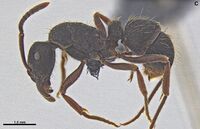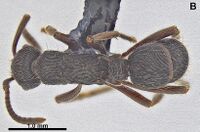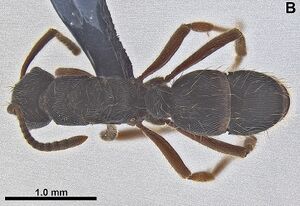Holcoponera pernambucana
| Holcoponera pernambucana | |
|---|---|

| |
| Scientific classification | |
| Kingdom: | Animalia |
| Phylum: | Arthropoda |
| Class: | Insecta |
| Order: | Hymenoptera |
| Family: | Formicidae |
| Subfamily: | Ectatomminae |
| Tribe: | Ectatommini |
| Genus: | Holcoponera |
| Species: | H. pernambucana |
| Binomial name | |
| Holcoponera pernambucana Santschi, 1929 | |
Little is known about the biology of G. pernambucana, but label information shows that this species is usually collected in areas of open vegetation such as the arboreal Caatinga, Canga and open grasslands, with at least one record also in the wetlands of Pantanal. Most of the collected specimens were sampled with soil baits of sardine and honey and, sometimes, with pitfall traps, suggesting that the species usually forages on the ground. (Camacho, Franco & Feitosa, 2020)
Identification
Camacho et al. (2020) - Medium size (TL 4.15−4.71). Eye in a depression on the side of the head, the outer rim extending slightly beyond the lateral margin of the head in frontal view. Scape very short, always shorter than 0.8 mm. In lateral view, mesosoma strongly convex without a metanotal impression. Tibiae completely punctuated.
This species, previously synonymized with Holcoponera striatula, is distinguishable from the latter by the aforementioned diagnostic characters. However, measurements and proportions of the scape in relation to the head are the principal means of distinguishing between the two species. Although the differences between this species and H. striatula are not striking, they seem consistent enough to define different species, especially since they occur in sympatry. During this revision, we were able to identify both H. striatula and H. pernambucana in the same area of the Parque Estadual de Vila Velha, Paraná, Brazil, the first one occurring in forest areas and the second one only in open field areas, with clear morphological differences. Additionally, a phylogenomic analysis of 2,500 ultra-conserved elements across 322 Gnamptogenys and related species (Camacho et al., in prep) supports our hypothesis that this is a separate lineage, recovering H. pernambucana as sister to Holcoponera moelleri.
Keys including this Species
Distribution
Camacho et al. (2020) - Holcoponera pernambucana is widely distributed in Brazil, occurring in the states of Bahia, Mato Grosso do Sul, Pará, Paraíba, Paraná, Pernambuco, Piauí, Rio Grande do Sul and Sergipe. The wide and patchy distribution might suggest that many records can still be found. In fact, since the species was synonymized under H. striatula by Brown (1958), many records of Holcoponera striatula may be G. pernambucana.
Distribution based on Regional Taxon Lists
Neotropical Region: Brazil (type locality).
Distribution based on AntMaps
Distribution based on AntWeb specimens
Check data from AntWeb
Countries Occupied
| Number of countries occupied by this species based on AntWiki Regional Taxon Lists. In general, fewer countries occupied indicates a narrower range, while more countries indicates a more widespread species. |

|
Biology
Castes
Queen
Nomenclature
The following information is derived from Barry Bolton's Online Catalogue of the Ants of the World.
- pernambucana. Holcoponera brasiliensis var. pernambucana Santschi, 1929h: 452, fig. 27 (w.) BRAZIL (Pernambuco) (attributed to Borgmeier).
- Type-material: syntype workers (number not stated).
- Type-locality: Brazil: Pernambuco, Tapera (B. Pickel).
- Type-depository: NHMB.
- Camacho, et al. 2020: 473 (q.).
- Junior synonym of striatula: Brown, 1958g: 229; Kempf, 1972a: 115; Bolton, 1995b: 210; Lattke, 1995: 186.
- Status as species: Camacho, et al. 2020: 454 (in key), 472 (redescription); Camacho, Franco, Branstetter, et al. 2022: 11.
- Distribution: Brazil.
Unless otherwise noted the text for the remainder of this section is reported from the publication that includes the original description.
Description
Camacho et al. 2020:
Worker
Worker: HL 0.91−1.03; HW 0.75−0.85; ML 0.41−0.49; SL 0.72−0.85; EL 0.15−0.19; WL 1.21−1.38; PL 0.35−0.40; GL 1.25−1.49; TL 4.15−4.71; CI 80.50−85.00; SI 95.60−100.00; OI 19.10−24.20 (n=19).
Body brown to black with lighter appendages, coppery to yellowish. Body predominantly covered by thin, long, erect and suberect hairs; hairs predominantly white to light beige; appendages densely covered by short to medium, decumbent hairs, directed apically, with some long suberect hairs sparsely distributed; 10 to 15 hairs at the anterior margin of clypeus, surpassing the basal margins of the mandible. Lateral portion of clypeus with a distinctively long hair directed anteriorly; two long hairs on the central portion of clypeus, just below the antennal insertions; two long hairs on the frontal lobes, close to the lateral margins. Scape covered with many decumbent hairs. Pygidium and hypopygium with abundant thick hairs on the entire surface.
Mandible with some conspicuous striae. Clypeus covered by longitudinal costulae. Head dorsum covered with long, slightly irregular longitudinal costulae from the anterior margin of clypeus to the occipital margin of the head. Ventral surface of head covered by costulae, in a converging pattern toward the ventral midline suture; occipital corner margin extends ventrally, not reaching the median suture of the ventral surface of the head. Mesosoma glossy and covered by narrow costulae, approximately 0.025 mm in width and slightly irregular margins, forming variable patterns on the dorsal surface. Pronotum with transverse costulae anteriorly, and longitudinal costulae on the dorsal surface. Dorsal surface of mesonotum, metanotum and propodeum with longitudinal costulae. Costulae of mesopleuron interrupted at posterior edge, delimiting the boundary between mesopleuron and metapleuron. Declivitous face of propodeum with longitudinal costulae, diverging towards the posterior margin of the propodeum. Petiole covered by narrow costulae, concentric in dorsal view, with transverse costulae throughout its length in frontal view. Coxae always covered by transverse costulae; on procoxa, costulae as wide as on the rest of the body. Segments I and II of gaster covered with longitudinal costulae. First gastral segment with at least five transverse costulae on anterior face.
Lateral margins of head straight and subparallel, slightly tapered anteriorly; triangular mandible; masticatory margins with many denticles, often looking inconspicuous; external margins of mandible slightly concave at half length. Anterior margin of clypeus strongly convex, clypeal lamella strongly projected in the central region, giving it a slightly pointed appearance in frontal view. Antennal scape narrow, slightly wider apically, surpassing vertex margin by about a sixth of the length. Compound eye small, rounded and convex, located slightly behind the anterior half of the head in frontal view and about seven ommatidia at larger diameter; eye inserted in a concavity, and, in frontal view, the outer rim of the eye does not extend beyond the side of the head; in lateral view, eye located behind the anterior half of the head. Vertex margin slightly concave medially; occipital corners prominent and rounded in lateral view.
Pronotum with angled humeral corners, giving it a slightly trapezoidal shape in dorsal view. Mesosoma compact and convex in lateral view, without a mesonotal impression. In dorsal view, lateral margins of declivitous face of propodeum divergent, the angle between the dorsal and declivitous face of propodeum apparent; propodeal spiracle not high, at the same level as the sculpture; propodeal spiracle distant from the declivitous margin by a distance equal to or greater than its opening and near the upper limit of the metapleural gland bulla; propodeal spiracle with wide opening. Propodeum without spines or projections. Mesepisternal suture wide, forming a large space between the posterior margin of propleuron and anterior of mesopleuron. Metacoxal spine very prominent, upright and long.
Petiole sessile; in lateral view, anterior and posterior margins of petiole subparallel; dorsal margin of petiole straight, slightly raised posteriorly. In dorsal view, petiole oval; in frontal view, petiole slightly pointed apically; subpetiolar process predominantly opaque, subquadrate, with a fenestra close to its posterior limit. Prora very prominent, V-shaped in ventral view. Second gastral tergite distinctly longer than the second sternite, giving the gaster an arched aspect in lateral view.
Queen
Dealate queen: HL 1.07; HW 0.91; ML 0.52; SL 0.96; EL 0.20; WL 1.57; PL 0.41; GL 1.82; TL 5.39; CI 85.04; SI 105.49; OI 21.97 (n=1).
Color, pilosity and sculpture as the workers. Head dorsum with one ocellus; compound eye larger than on workers. Scutum flat in lateral view; notaulices not distinguishable; indistinguishable parapsidal lines through the sculpture; parapsides obsolete; tegulae wide, rounded, dark color and translucent; suture between anepisternum and katepisternum absent. Axillae laterally rounded; scutum-scutellum sulcus poorly marked. Scutellum rounded in lateral view. Dorsal surface of propodeum slightly convex below the level of the scutellum, with well-defined lateral margins.
Type Material
Camacho et al. (2020) - BRAZIL: Pernambuco: B. Pickel. 8° 3’0.00”S, 34°53’60.00”W. ANTC40090 (1 worker) (CASENT0915125) Naturhistorisches Museum, Basel [examined by images].
Etymology
Camacho et al. (2020) - Santschi (1929) likely named this species after the state of the type locality, Pernambuco, Brazil. The name is a feminine noun in the genitive case.
References
- Albuquerque, E., Prado, L., Andrade-Silva, J., Siqueira, E., Sampaio, K., Alves, D., Brandão, C., Andrade, P., Feitosa, R., Koch, E., Delabie, J., Fernandes, I., Baccaro, F., Souza, J., Almeida, R., Silva, R. 2021. Ants of the State of Pará, Brazil: a historical and comprehensive dataset of a key biodiversity hotspot in the Amazon Basin. Zootaxa 5001, 1–83 (doi:10.11646/zootaxa.5001.1.1).
- Camacho, G.P., Franco, W., Branstetter, M.G., Pie, M.R., Longino, J.T., Schultz, T.R., Feitosa, R.M. 2022. UCE phylogenomics resolves major relationships among Ectaheteromorph ants (Hymenoptera: Formicidae: Ectatomminae, Heteroponerinae): A new classification for the subfamilies and the description of a new genus. Insect Systematics and Diversity 6(1): 5; 1–20 (doi:10.1093/isd/ixab026).
- Camacho, G.P., W. Franco and R. M. Feitosa. 2020. Additions to the taxonomy of Gnamptogenys Roger (Hymenoptera: Formicidae: Ectatomminae) with an updated key to the New World species. Zootaxa. 4747:450-476 doi:10.11646/zootaxa.4747.3.2.




